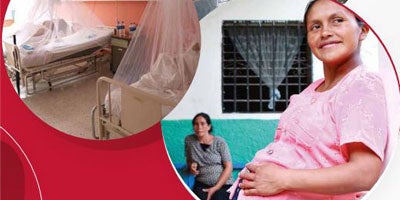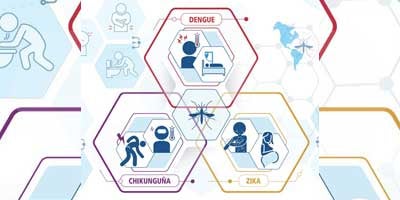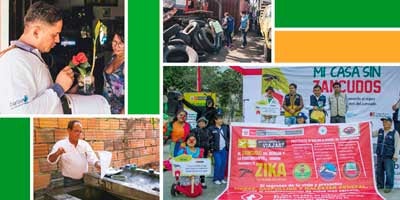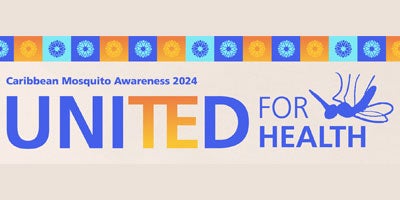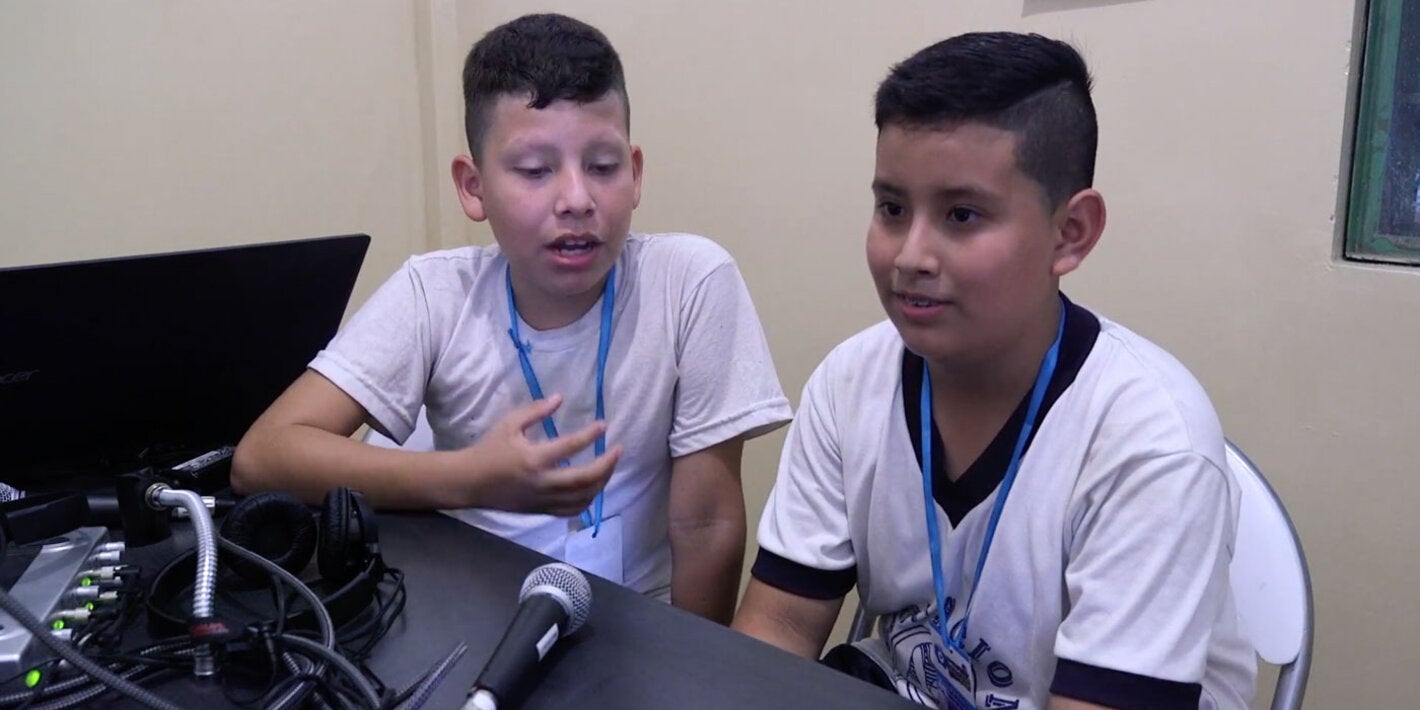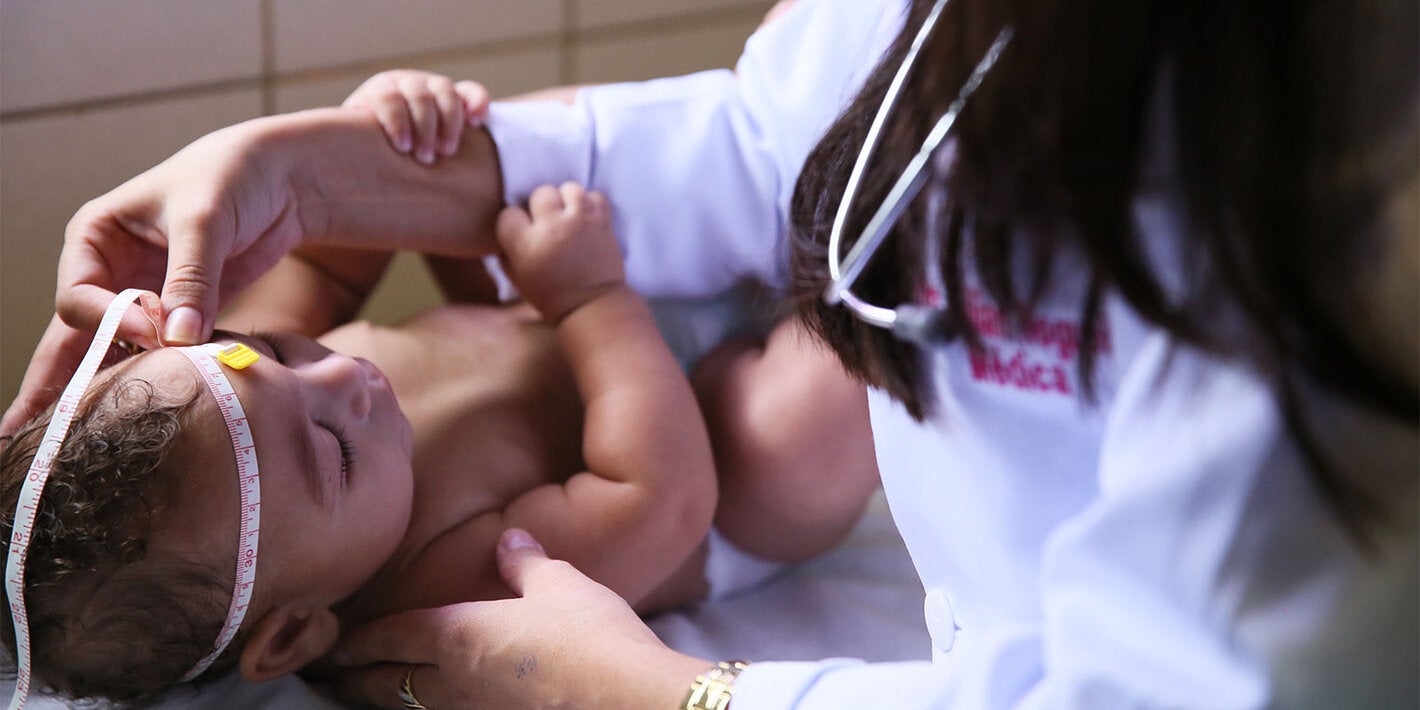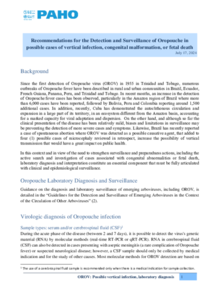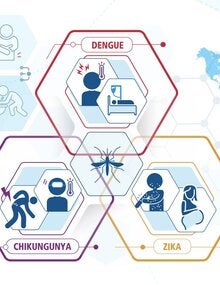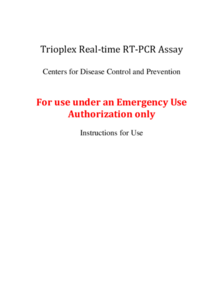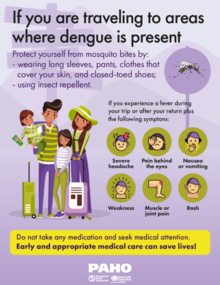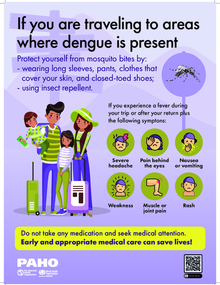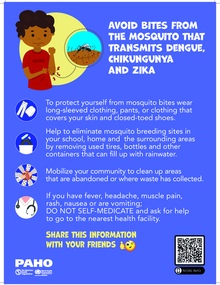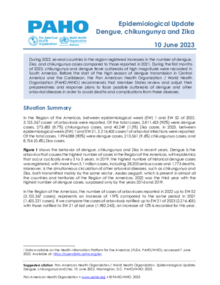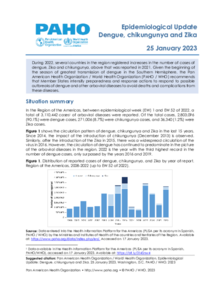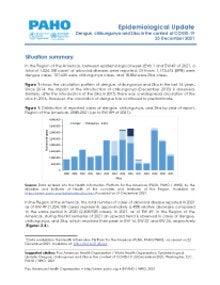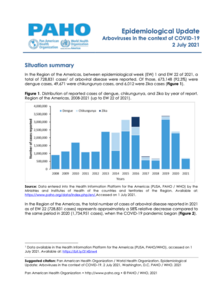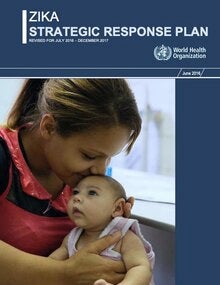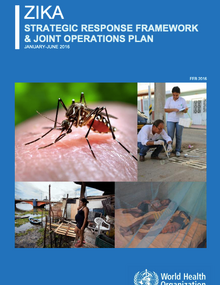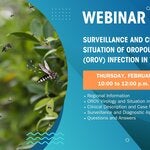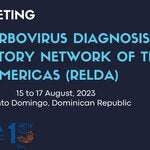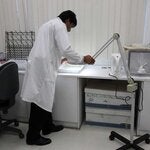SUBMENU
Zika fever is an infectious disease caused by the Zika virus (ZIKV) and transmitted through the bite of Aedes mosquitoes infected with ZIKV. The disease is mainly characterized by a rash (mainly maculopapular and cephalocaudal distribution), pruritus, non-purulent conjunctivitis, arthralgia, myalgia, periarticular edema, and fever.
One in four infected people may develop symptoms, but in those who are affected the disease is usually mild, with symptoms lasting between 2 and 7 days. The clinical appearance is often similar to dengue or chikungunya, also a mosquito-borne illness.
• The virus was isolated for the first time in 1947 in the Zika forest in Uganda. Since then, it has remained mainly in Africa, with small and sporadic outbreaks in Asia.
• In 2007, a major epidemic was reported on the island of Yap (Micronesia), where nearly 75% of the population was infected.
• In May 2015, the public health authorities of Brazil confirmed transmission of the Zika Virus in the country's northeast. In July 2015, it was discovered that ZIKV was associated with Guillain-Barré syndrome.
• In October, it was also linked to central nervous system malformations at birth, which includes microcephaly.
• In February 2016, the World Health Organization (WHO) declared ZIKV-related microcephaly a Public Health Emergency of International Concern (PHEIC). However, in November 2016, WHO declared the end of the emergency.
• Zika now is endemic in the Americas. For more updated epidemiological information, learn
more on Plisa.
About Zika...
ZIKV is transmitted from person to person mainly through the bite of the Aedes aegypti mosquito infected with the virus. Sexual transmission has also been documented.
The estimated incubation period (time between exposure and symptom onset) for ZIKV disease is 3 to 14 days.
Most people infected with ZIKV are asymptomatic. Those who develop the disease usually present a mild picture that includes rash (mainly maculopapular and cephalocaudal distribution), pruritus, non-purulent conjunctivitis, arthralgia, myalgia, periarticular edema and fever. These symptoms usually last 2 to 7 days.
There is no specific medicine to treat Zika.
There is scientific consensus that ZIKV is a cause of microcephaly and Guillain-Barré syndrome.
By blood
Currently there is limited knowledge of Zika virus and the ways it can be transmitted. However, the following suggest it may present a risk to blood safety:
- The virus has been detected in blood donors in areas where Zika is circulating
- Transmission of related viruses (dengue, chikungunya and West Nile virus) by blood transfusion has been documented, and thus transmission of Zika virus is possible
- Brazilian health authorities have reported 2 cases of possible transmission of the virus by blood transfusion.
Studies are needed to assess the prevalence of the virus and of transmission through blood transfusion and blood products to better understand the risk Zika presents.
What precautions should be taken to ensure that the blood supply is safe in countries where Zika infection is occurring?
Specific measures recommended to prevent Zika infection should be part of an overall blood strategy based on the guidelines in PAHO's Plan of Action for Universal Access to Safe Blood 2014-2019 for strengthening national blood programs. These guidelines recommend:
- Organizing blood services well and concentrating processes
- Implementing quality management programs throughout the transfusion chain and ensuring Good Manufacturing Practices;
- Ensuring that blood donation is voluntary, repeated, and from low-risk populations, and eliminating mandatory replacement donation;
- Ensuring the appropriate use of blood and blood products;
- Providing continuous training for blood services staff and blood products users
- Providing health surveillance, hemovigilance, and risk management.
Ideally, the blood supply during a regional outbreak of Zika should be maintained by increasing blood collections in non-affected areas.
In non-affected areas, consideration may be given to deferring potential donors who have recently visited areas with ongoing transmission of Zika virus infection for 28 days after their departure from these areas.
By sexual contact
The most common form of Zika transmission is through mosquito bites, but the virus has been isolated in semen, and cases of sexual transmission have been observed. Currently the available evidence is being analyzed to better understand the public health impact of sexual transmission of Zika.
The IHR Emergency Committee on Zika virus, at its meeting March 8, 2016, said that pregnant women should be advised not travel to areas of ongoing Zika virus outbreaks; pregnant women whose sexual partners live in or travel to areas with Zika virus outbreaks should ensure safe sexual practices or abstain from sex for the duration of their pregnancy.
What can be done to prevent sexual transmission?
All patients (male and female) with Zika virus infection and their sexual partners (particularly pregnant women) should receive information about the potential risks of sexual transmission of Zika virus, contraceptive measures and safer sexual practices, and should be provided with condoms when feasible.
Women who have had unprotected sex and do not wish to become pregnant because of concern with infection with Zika virus, should also have ready access to emergency contraceptive services.
Sexual partners of pregnant women living in or returning from areas where local transmission of Zika virus is known to occur, should use safer sexual practices or abstinence from sexual activity for the duration of the pregnancy.
Mother to child transmission
There is more evidence on this type of transmission. Research is currently under way on the risk of mother-to-child transmission of the virus and its possible effects on babies. Pregnant women in general, and particularly those who develop symptoms of Zika virus infection, should be closely monitored by health providers.
Can mothers with Zika infection breastfeed their baby?
There are currently no documented reports of Zika virus being transmitted to infants through breastfeeding. In countries with ongoing transmission of Zika virus no adverse neurologic outcomes or severe diseases have been reported to date from infants with postnatally acquired Zika infection. Any change to this situation should be carefully monitored. In light of available evidence, the benefits of breastfeeding for the infant and mother outweigh any potential risk of Zika virus transmission through breast milk.
Who is at risk of Zika infection?
Anyone not previously exposed to the virus and who lives in an area where the mosquito is present, and where imported or local cases have been reported, may be infected. Since the Aedes mosquito is found throughout the Region (except in continental Chile and Canada), it is likely that outbreaks will occur in other countries that have not yet reported any cases.
How is Zika diagnosed?
Diagnosis is based on clinical symptoms and epidemiological circumstances (such as Zika outbreak in the patient's area or trips to areas where the virus is circulating).
Blood tests can help to confirm the diagnosis. Some (virological PCR tests) are useful in the first 3-5 days after the onset of symptoms, while others (serological tests) detect the presence of antibodies but are useful only after five days.
Once it has been demonstrated that the virus is present in a given area or territory, confirmation of all cases is not necessary, and laboratory testing will be adjusted to routine virological surveillance of the disease.
Which is the difference between Zika, dengue, and chikungunya?
All these diseases present similar symptoms, but certain symptoms suggest one disease or another:
Dengue usually presents with higher fever and more severe muscle pain. There can be complications when the fever breaks: attention should be paid to warning signs such as bleeding.
Chikungunya presents with higher fever and more intense joint pain, affecting the hands, feet, knees, and back. It can disable people, bending them over so that they cannot walk or perform simple actions such as opening a water bottle.
Zika does not have clearly characteristic features, but most patients have skin rashes and some have conjunctivitis.
What treatment is there?
Treatment consists of relieving pain, fever, and any other symptom that inconveniences the patient. To prevent dehydration, it is recommended to control the fever, rest, and drink plenty of water. There is no vaccine or specific drug for this virus.
Can it cause death?
In the past, Zika had very limited geographical and demographic distribution, and there was no evidence that it caused death. However, in the current outbreak in the Region of the Americas, cases have been reported of more serious manifestations and complications that have sometimes resulted in death.
- WHO: Zika virus and complications: Questions and answers
- WHO: Dispelling rumours around Zika and complications; 2016
What measures should be taken to prevent Zika virus infection?
Prevention involves reducing mosquito populations and avoiding bites, which occur mainly during the day. Eliminating and controlling Aedes aegypti mosquito breeding sites reduces the chances that Zika, chikungunya, and dengue will be transmitted. An integrated response is required, involving action in several areas, including health, education, and the environment.
To eliminate and control the mosquito, it is recommended to:
- Avoid allowing standing water in outdoor containers (flower pots, bottles, and containers that collect water) so that they do not become mosquito breeding sites.
- Cover domestic water tanks so that mosquitoes cannot get in.
- Avoid accumulating garbage: Put it in closed plastic bags and keep it in closed containers.
- Unblock drains that could accumulate standing water.
- Use screens and mosquito nets in windows and doors to reduce contact between mosquitoes and people.
To prevent mosquito bites, it is recommended that people who live in areas where there are cases of the disease, as well as travelers and, especially, pregnant women should:
- Cover exposed skin with long-sleeved shirts, trousers, and hats
- Use repellents recommended by the health authorities (and apply them as indicated on the label)
- During the day, sleep under mosquito nets.
People with symptoms of Zika, dengue, or chikungunya should visit a health center.
Which countries have reported cases of Zika in the Americas?
On 3 March 2014, Chile notified PAHO/WHO that it had confirmed a case of indigenous transmission of Zika virus on Easter Island, where the virus continued to be detected until June 2014.
In May 2015, the public health authorities of Brazil confirmed the transmission of Zika virus in the northeast of the country. Since October 2015, other countries and territories of the Americas have reported the presence of the virus.
What causes rapid transmission in an area?
There are two factors for rapid transmission (documented in other countries): (1) Since this is a new virus to the Americas, the entire population is susceptible, lacking defenses to Zika virus; and (2) The Aedes mosquito is widespread in the Region, given the climatic conditions, temperature, and humidity in tropical countries.
Is it advisable to travel to countries where Zika virus is circulating?
PAHO/WHO does not recommend any travel or international trade restrictions related to Zika virus outbreaks. Travelers are advised to take the suggested precautions to prevent mosquito bites.
Pregnant women should be advised not travel to areas of ongoing Zika virus outbreaks; pregnant women whose sexual partners live in or travel to areas with Zika virus outbreaks should ensure safe sexual practices or abstain from sex for the duration of their pregnancy. Travelers to areas with Zika virus outbreaks should be provided with up to date advice on potential risks and appropriate measures to reduce the possibility of exposure to mosquito bites and, upon return, should take appropriate measures, including safe sex, to reduce the risk of onward transmission.
- More information for travelers to areas with Zika circulation
How many Zika cases have been reported in the Region of the Americas?
Countries begin reporting when they detect the circulation of the virus in their territories. Maintaining a case count is difficult because symptoms of the disease tend to be mild and not everyone affected is seen by health services. What is most important is to detect the circulation of the virus, strengthen the response of health services, and step up surveillance of serious cases and complications.
- For more information, see the latest Zika situation
About Aedes aegypti...
Aedes aegypti is the vector that presents the greatest risk of arbovirus transmission in the Americas and is present in almost all countries of the hemisphere (except Canada and continental Chile). It is a domestic mosquito (that lives in and near houses) that reproduces in any artificial or natural container that contains water.
The mosquito can complete its life cycle, from the egg to the adult, in 7-10 days; adult mosquitoes usually live 4 to 6 weeks. The female Aedes aegypti is responsible for the transmission of diseases because she needs human blood for the development of her eggs and for her metabolism. The male does not feed on blood.
The mosquito is most active early in the morning and at dusk, so these are the periods of greatest risk of bites. However, females, who need to continue feeding, will seek a source of blood at other times. The female Aedes aegypti feeds every 3-4 days; however, if they cannot draw enough blood, they continue feeding each moment they can.
Aedes aegypti prefers to lay its eggs in artificial containers that contain water (drums, barrels and tires, mainly) in and around homes, schools and workplaces. Aedes aegypti eggs can withstand dry environmental conditions for more than a year: in fact, this is one of the most important strategies that the species uses to survive and spread.
To eliminate mosquitoes, the following actions are recommended: avoid collecting water in open-air containers (pots, bottles or other containers that can collect water) so that they do not become breeding sites for mosquitoes; adequately cover water tanks and reservoirs to keep mosquitoes away; avoid accumulating garbage, throwing garbage in closed plastic bags.
- PAHO/WHO provides advice and technical support to prevent and control dengue. This work is carried out based on the Integrated Management Strategy for the Prevention and Control of Arboviral Diseases, which was adopted by PAHO/WHO Member States in 2016 (CD55.R6).
- In 2008, PAHO/WHO Member States established a Network of Dengue Laboratories of the Americas (RELDA) to strengthen technical capacities for dengue diagnosis. Currently, RELDA has been expanded to include chikungunya and Zika fever and comprises 40 laboratories in 35 countries in the Region.
- PAHO/WHO is supporting the development of an integrated epidemiological surveillance system model for dengue, chikungunya, and Zika. This model integrates epidemiological, clinical, laboratory and entomological surveillance to generate standardized and timely information for decision making. A technical document with guidelines for integrated epidemiological surveillance of arboviruses will be published in 2024. You can find the case definitions here.
- Under the concept of collaborative surveillance, PAHO/WHO develops and makes virtual collaboration spaces (ECV) available to countries. Through the ECVs, countries and PAHO collaborate in the real-time analysis of their epidemiological, clinical, laboratory, and entomological data, as well as the generation of automated reports and bulletins.
- PAHO/WHO promotes a clinical technical cooperation bundle in the countries to strengthen national capacities for clinical diagnosis and case management of dengue, chikungunya, and Zika in the Region. This bundle includes technical documents and clinical guidelines, virtual self-learning courses, a regional virtual classroom to train the trainers, and the formation of national networks of clinical experts in arboviral diseases.
- PAHO/WHO is working to strengthen regional and national capacity for the prevention and control of vectors. To achieve this, the organization has implemented the Plan of Action on Entomology and Vector Control 2018-2023. As part of this plan, various initiatives have been developed to improve entomological surveillance systems, monitor and manage resistance to insecticides used in public health, and train professionals in entomology through a virtual course on Surveillance and Control of Vectors of Public Health Importance. Additionally, PAHO/WHO is promoting the implementation of a new model of interventions for the control of Aedes aegypti and providing support to countries for the rational deployment of new technologies and approaches for vector control.




